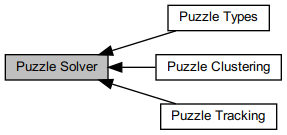Code for working with puzzles on a controlled workspace. More...

Modules | |
| Puzzle Clustering | |
| Interfaces for clustering puzzle pieces. | |
| Puzzle Tracking | |
| Code that assists with tracking the movement of puzzle pieces and also associating them to a known solution. | |
| Puzzle Types | |
| Classes that abstract different puzzle (arrangement) types. | |
Classes | |
| class | Board |
| Class description for a board, which is a locality sensitive bag. More... | |
| class | CfgCorrespondences |
| Configuration setting specifier for Correspondences class. More... | |
| class | Correspondences |
| Class that compares two boards and generates correspondences across them. More... | |
| class | FromLayer |
| A basic detector class that processes a layered image (or mask and image) detection output. More... | |
| class | FromSketch |
| What is FromSketch?? More... | |
| class | PieceStatus |
| PieceStatus used to keep track of the status of pieces. More... | |
| class | PuzzleTemplate |
| Data class containing puzzle piece information. More... | |
| class | Template |
| Stores and encapsulates a template instance of a visual puzzle piece. More... | |
Detailed Description
Code for working with puzzles on a controlled workspace.
The puzzle solver codebase revolves around the Board class, which is a bag of puzzle Pieces. As a bag, there is no need for the pieces to actually be put in such a way as to create a solved puzzle. Rather, the board class simply consists of pieces on a planar workspce. To this base class, there are extensions that perform image processing to extract a puzzle board from a processed image (or partially processed image), that associate puzzle pieces across Board instances, and that cluster pieces in a Board instance.
Puzzles
An additional set of extensions provides structure to the Board bag as would actually occur for a puzzle. These are the Adjacent, Arrangement, Interlocking, and Gridded class packages. Briefly, an Arrangement is just a set of pieces placed in particular locations; an Adjacent puzzle is one for which adjacency rules apply; an Interlocking puzzle is one where adjacency involes interlocking pieces together; and a Gridded puzzle is one where the adjacency is along a north-south, east-west grid such that the puzzle is rectangular. This last case covers most commonlgy found puzzles. The Interlocking case covers irregularly shaped puzzle.
Puzzle Tracking
Additional code for tracking the completion process of a puzzle exists here, as does code for calibrating what the puzzle solution looks like. Puzzle tracking requires creating a unique signature for each puzzle piece, then using it to keep track of how the pieces move around. If all of the pieces can indeed have a unique signature, then data association against the signature with a calibrated solution board supports robotic puzzle solving, by indicating where puzzle pieces need to be placed to create the solution.
Puzzle Clustering
Because a first step in solving a puzzle involves clustering the pieces according to their appearance, there exist approaches to breaking up a puzzle into different clusters for sorting.